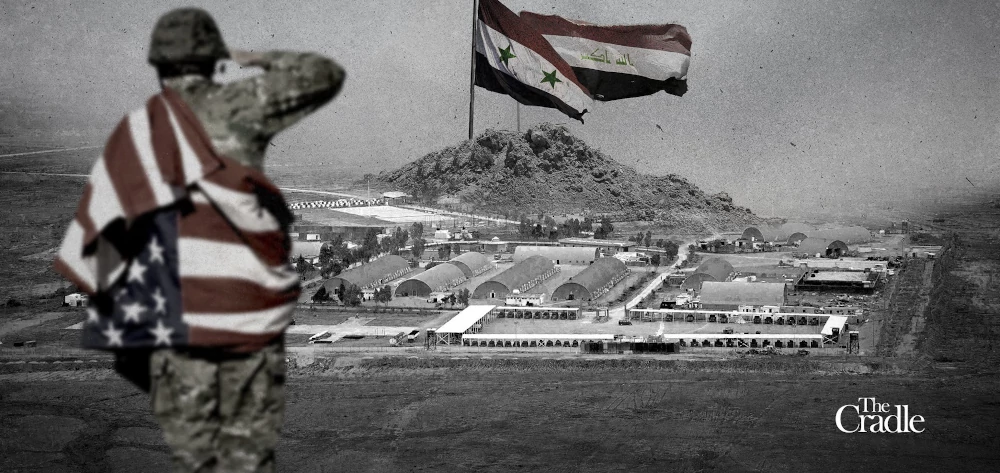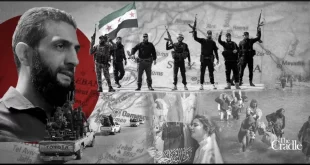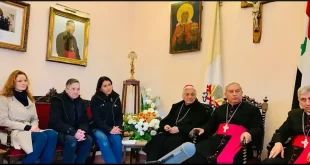by Khalil Harb, published on The Cradle, December 8, 2o23
By unequivocally supporting Israel’s military assault on Gaza, the US has exposed itself to vulnerabilities across West Asia, particularly in the already volatile Iraqi and Syrian theaters.
Far from fostering peace or stability, illegal US troop presence in these areas has heightened tensions with anti-Israel populations highly supportive of the Palestinian resistance in Gaza.
Washington has gone too far in its alignment with Tel Aviv now, fully disregarding the interests, sentiments, and stances of Arab and Muslim-majority countries, governments, and citizens alike.
Despite two months of relentless Israeli carnage and destruction, the US State Department continues to offend these populations with disingenuous statements like: “I have not seen evidence that they’re (Israel is) intentionally killing civilians.”
If the US invasion of Iraq in 2003 created a hostile Arab and Islamic environment at the popular level, along with hundreds of thousands of corpses, massacres, and millions of displaced people, a multifaceted catastrophe whose effects are still deeply etched in the minds of the peoples of the region, and have not healed from it, open support for the criminal policy of the Israeli government now, including the delivery of 10,000 tons of weapons and equipment on a bridge. Continuous air (200 cargo planes) since October 7, according to the Israeli Defense Ministry, has added all possible elements of distortion and tension in the face of the United States and its presence.
Although the illegal US invasion of Iraq took place 20 years ago, strong remnants of hostility against the Americans remain locally and regionally. It is hard to forget the millions displaced, the hundreds of thousands of corpses, the torture and humiliation in Abu Ghraib and other US prison camps, and the babies still born with defects from the sheer intensity of ‘Shock and Awe.’
Those who have not yet healed from those horrors, are now watching the US help Israel to wreak the same carnage on their Arab and Muslim brethren in Gaza, inflaming sentiments everywhere.
Persistent presence in the region
Since 7 October the US has supplied Tel Aviv’s war with at least 10,000 tons of weapons and equipment, via at least 200 cargo planes – deliveries that continue daily and are raising fresh doubts about the sustainability and purpose of US occupation forces in Iraq and Syria.
These are optics the Americans would do well to avoid: their occupation troops in Iraq and Syria, backing the occupation troops destroying Gaza.
Speaking to The Cradle, Haj Abu Alaa al-Walai, secretary general of the Sayyid al-Shuhada Brigades, contends that the US remains in these countries not for ISIS or security, but to “cut the artery” of the resistance in the region.
With strikes against US occupation forces and installations at a record high, skepticism over military presence in these countries has reared its head again. Recall the 2019 efforts of then-President Donald Trump to withdraw all US forces from Syria, a country of “sand and death.” Although the ISIS threat was long gone, war lobbies attacked Trump mercilessly, his Secretary of Defense, James Mattis, resigned in protest, and Israeli Prime Minister Benjamin Netanyahu appealed to him to postpone the withdrawal – which the US president did.
Now, Republican Senator Rand Paul has initiated a movement to withdraw US troops from their illegal bases in Syria, emphasizing that:
“The American people are tired of endless wars in the Middle East, and yet there are 900 American troops still in Syria without vital US interests at stake, no definition of victory, no exit strategy, no congressional authorization to be there.”
Rand is basing his resolution on “war powers” passed by Congress since 1973, which requires US administrations to withdraw troops from hostile territory as long as Congress has not declared war.
Given the criticism both in the US and in the countries it occupies, the US military has cosmetically transformed its presence in Iraq from a combat role to an “advisory and support mission” to justify a continued military role.
But suspicions about the US role in supporting ISIS, and its actions against Iraq’s own security forces during the liberation battle, still linger and thrive, reinforced by questionable actions, such as instances of US airstrikes targeting Iraqi Popular Mobilization Units (PMU) during their battles against ISIS and obstructing their efforts in liberating Iraqi territory.
While ISIS was the pretext used for the 2014 return of US troops to Iraq, the region’s Axis of Resistance agrees it is no coincidence that ISIS militants were able to breach the Syrian-Iraq border (advancing from the Syrian city of Raqqa on 8 June, 2014 toward the Iraqi city of Mosul to declare its caliphate) under this American watch.
Even after the Iraqi government’s 2017 official declaration of victory over ISIS, US forces have refused to budge, citing ongoing operations against the much-diminished ISIS – which Iraqi security forces are more than capable of controlling.
Targeting Iraq’s anti-ISIS forces
The dwindling number of operations against ISIS in June, for example, where a small number of alleged terrorists were killed (13) or arrested (21) across both Syria and Iraq – and only with the cooperation of local US Kurdish allies – prompt some obvious questions.
Do such meager results, that cost billions of dollars, merit the stationing of thousands of American soldiers between military bases in Iraq and bases in northeastern Syria, and at al-Tanf base in southern Syria – all to kill a single terrorist in Syria last June?
Washington’s hubris disregards Iraq’s significant allocation of $22 billion to its own Ministry of Defense. The Iraqi army, which includes the PMU forces, has gained considerable combat experience in counterterrorism efforts.
But since Iraq’s victory over ISIS, the US has focused its sights on targeting the PMU, assassinating key leaders, and violating Iraq’s sovereignty and territorial integrity time and time again. Washington completely ignored the vote of the Iraqi Council of Representatives on 5 January, 2020 on a resolution to end the presence of all foreign forces on Iraqi territory. That vote took place days after the Pentagon assassinated Iraqi PMU deputy leader Abu Mahdi al Muhandes and Iranian Quds Force General Qassem Soleimani.
The Americans have also set their sights on Al-Walai, now designated a “global terrorist” because his brigades “planned and participated in attacks against US personnel in Iraq and Syria,” he tells The Cradle, and adds:
“In the special dimension, the American occupation finds that the line of the Axis of Resistance, which extends through Iran, Iraq and Syria to the rest of the countries, represents the aortic artery of the axis, and that the presence of the American occupation in Iraq and Syria will contribute from its point of view to cutting that artery.”
In Syria, US forces entered in 2014 during the rise of ISIS, conducted airstrikes against both terrorists and Syrian forces, then occupied swathes of eastern Syria and targeted the state itself in 2017.
Since 17 October, there have been more than 70 attacks on various locations of US forces between Iraq and Syria, as part of responses from the resistance factions to Washington’s completely biased position towards Israel in the massacres it is committing in Gaza.
Washington ignores the warnings
Despite warnings from the region’s Resistance Axis, the US went ahead and deployed military reinforcements, including warships, two aircraft carriers, and thousands of troops, ostensibly as direct support for any and all Israeli actions.
Washington has attempted to portray this move as a measure to prevent the regional escalation of the conflict, but the locals aren’t buying it. For starters, this narrative sharply contradicts US actions, considering the ongoing raids by US forces on resistance sites in Iraq and Syria that have resulted in numerous casualties.
Moreover, the US is actively and vigilantly countering missiles and drones launched by the Yemeni armed forces toward Israel. It is yet another inconsistency that undermines Washington’s claim that its military build-up is to thwart a regional war.
According to Walai, the situation is becoming untenable for the Iraqi government too:
“The American occupation, through its continuous violations of Iraqi sovereignty and its shedding of Iraqi blood through its treacherous air operations against Iraqis, and without the consent or knowledge of the Iraqi government, has dropped itself from the status of consultation and training, and these expressions no longer have any meaning, and its presence has become clear that it is a military occupier, a combat presence and lethal forces that have nothing to do with training or consultation.”
Obstacles to peace and stability
The dire situation in Gaza has introduced new complexities in the longstanding confrontation between the Axis of Resistance and US occupation forces. Washington’s strategic maneuvers, such as playing the Kurdish card in northeastern Syria, ensure the continued destabilization of the Syrian state, fostering internal conflict and obstructing Damascus’ control over occupied territories.
The Al-Tanf base serves as a tool to prevent Syrian dominance in the Badia (desert area) and the southern part of the country, where only groups aligned with US interests are trained. The base also acts as a barrier at the triple point of convergence between Jordan, Iraq, and Syria. It seeks to block the line of communication from Baghdad to Damascus, mirroring the role of the US’ Ain al-Assad base in western Iraq, which serves to hinder Iran’s westward movement toward the Mediterranean.
Consequently, missiles and suicide drones will continue to target American soldiers – in greater numbers and with more casualties – adding dangerous risk and uncertainty to their unwanted presence.
The Intercept recently disclosed classified documents detailing thefts of “sensitive” military equipment from US bases in Iraq and Syria, which has raised further alarm over the effectiveness of US measures to protect its troops.
While the US occupation disrupts the development of political, economic, social, and security ties between West Asian states and populations, it is also well aware that the Iranians, Turks, Iraqis, Syrians, and Russians expect that those days may be numbered.
The recollection of the collaborative victory on 18 June, 2017, when Iraqi resistance factions and the Syrian army, along with their allies, united at their shared border after defeating ISIS in Anbar province, fuels hope for a future free from foreign occupation. And the US-Israeli wholesale massacre of Palestinians has drawn that future nearer.
Khalil Harb is a Beirut-based journalist and former editor-in-chief of the Lebanese daily Al-Safir. He has also worked for the Associated Press and the Lebanese An-Nahar newspaper. Khalil is a graduate of the American University in Cairo.
 Syria Support Movement solidarity with the Syrian people
Syria Support Movement solidarity with the Syrian people





